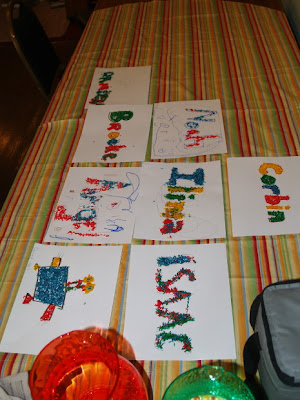
 Some might think that libraries are where you find books, but during the summer, the Eureka Springs Carnegie Public Library is where you find hands on science (and crafts) for children of all ages. Manipulation of materials through the use of crafts is one of the first steps in engaging children in science. The program was produced by my wife Jean as one of the many children's programs available to children at our library. It shows true integration of the Wisdom of the Hands in the development of intellect. Jean tells all her Pee Wees, "You are all scientists, and you are all artists." So I will repeat this quote from an earlier post:
Some might think that libraries are where you find books, but during the summer, the Eureka Springs Carnegie Public Library is where you find hands on science (and crafts) for children of all ages. Manipulation of materials through the use of crafts is one of the first steps in engaging children in science. The program was produced by my wife Jean as one of the many children's programs available to children at our library. It shows true integration of the Wisdom of the Hands in the development of intellect. Jean tells all her Pee Wees, "You are all scientists, and you are all artists." So I will repeat this quote from an earlier post:The discoveries of science, the works of art are explorations — more, are explosions, of a hidden likeness. The discoverer or the artist presents in them two aspects of nature and fuses them into one. This is the act of creation, in which an original thought is born, and it is the same act in original science and original art.
--- Jacob Bronowski

A friend alerted me to an article in USA Today called New 'science of learning' could reinvent teaching techniques by Dan Vergano. It makes some important points and then jumps to all the wrong worn out conclusions. It states:
•Learning is computational. Even infants and toddlers possess innate capabilities to see and hear patterns, something psychologists doubted decades ago. Reinforcing those capabilities by teaching patterns early might sharpen kids' brains.The most interesting and alarming thing in the article is the sentence, "Learning is computational". The meaning of the word computational is as follows: (Adj.)- of or involving computation or computers; as in "computational linguistics". While the second part of the point involving pattern recognition is true, the insertion of that word computational, particularly for the casual or less informed reader implies that computers are a necessary part of education, even though they are only a creation of the last four decades of technology, and as though education and learning didn't exist before their invention. Have we become insane? How has such nonsense become so widely accepted?
•Learning is social. People, even infants, learn better through social cues. We "most readily learn and re-enact an event when it is produced by a person," Meltzoff and colleagues write. "Social factors also play a role in life-long learning — new social technologies (for example, text messaging, Facebook, and Twitter) tap humans' drive for social communication," they add.
•Learning is driven by brain circuitry. Brain cells fired up during both perception and action overlap in people, which allows students to identify with their teachers and speeds learning.
"The young learn best from people in human social interaction. But one of the fundamental characteristics of the human mind is our flexibility and our inventiveness — our capacity to invent tools to amplify our own sensory and motor abilities," Meltzoff says by e-mail.
So, the researchers say, the goal for education in this century is to create teaching tools — such as robots, computer programs or science fairs — that produce the same benefits of the very best teaching situation, one-to-one tutoring.
Someday, however, perhaps researchers will notice that if you engage children's hands, their curiosity will be unleashed. Contrived systems of robotics and computer programs that insist that children merely mimic the creativity already built into the machine are not the answers to the challenges of American education. The real, unstated purpose of the New "Science of learning" is to cut costs, by substituting new technologies for the proven, widely acknowledged need for social engagement. Surely we can outsource teaching in the same manner through which we have outsourced tech support, don't you think? That way, a very small group of American investors can make big money, hand over fist, while our children become mindless consumers, helpless in the face of corporate manipulation and teachers join the unemployment lines along with all those displaced from American industry.
I concur with your alarm. Fortunately, there are quite a few of us "learning scientists" (guilty as charged) who are actively investigating some of the very same processes you're passionate about: the need for authentic, meaningful activities; whole mind/body engagement; learning how to cope with frustration and experience true joy, etc. We tend not to think much of the "computational" agenda, either.
ReplyDeleteAs I mention in the Bronowski quote, there is a very fine line between the arts and real science, and the pee wee science program is the perfect illustration. You mention being a "learning scientist" and I invite you to share more. I also see in your sig photo that you are a box maker. there spiral is an interesting symbol. It can be water swirling down the drain, or the whole of the cosmos.
ReplyDeleteStart 'em young! Let them learn with their whole body. Computation is one part, but at a young age not as important physical activity. By the way, the "word verification" word as I type is "unicrat." I'm not sure what it means, exactly, but it does have a ring to it.
ReplyDeleteMario